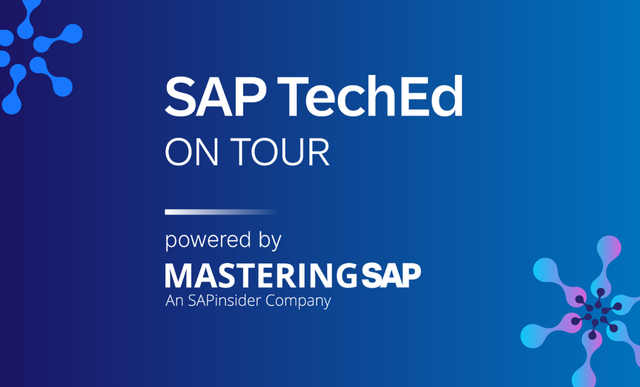SAP S/4HANA
Filter By
Browse By
- SAP Analytics and AI
- SAP Application Development and Integration
- All SAP Application Development and Integration
- SAP ABAP
- SAP ABAP Development Tools
- SAP ABAP Test Cockpit
- SAP API Management
- SAP BAPI
- SAP Basis
- SAP BRF
- SAP Business Application Studio
- SAP CMS
- SAP Design Studio
- SAP Development Tools
- SAP DevOps
- SAP EAI
- SAP EDI
- SAP Extension Suite
- SAP Fiori
- SAP Fiori Elements
- SAP Integration Suite
- SAP Low Code Application Development
- SAP Low Code Automation
- SAP Netweaver
- SAP Release Management
- SAP UI5
- SAP Web Application Server
- SAP Web IDE
- SAP Business Process Management
- SAP Center of Excellence
- SAP CIO
- SAP Customer Experience
- SAP Data and Data Management
- All SAP Data and Data Management
- SAP BW
- SAP BW/4HANA
- SAP Crystal Reporting
- SAP Data Archiving
- SAP Data Center
- SAP Data Governance
- SAP Data Integration
- SAP Data Migration
- SAP Data Quality
- SAP Data Services
- SAP Data Strategy
- SAP Data Visualization
- SAP Data Warehouse Cloud
- SAP DMS
- SAP Document Control
- SAP EIM
- SAP ETL
- SAP ETL Tools
- SAP HANA
- SAP HANA Administration
- SAP HANA Deployment Infrastructure
- SAP HANA Studio
- SAP Master Data
- SAP Master Data Governance
- SAP MDM
- SAP Enterprise Architect
- SAP Enterprise Asset Management
- SAP ERP
- SAP Finance
- All SAP Finance
- SAP Accounting
- SAP AR AP
- SAP Asset Accounting
- SAP Billing Systems
- SAP BPC
- SAP BRIM
- SAP Cash Management
- SAP Central Finance
- SAP Controlling
- SAP COPA
- SAP Cost Center Accounting
- SAP e-invoicing
- SAP FICO
- SAP Finance Automation
- SAP Financial Closing Cockpit
- SAP Financial Consolidation
- SAP Financial Planning
- SAP FX Risk
- SAP General Ledger
- SAP Global Tax Management
- SAP Hyperion
- SAP Order to Cash
- SAP Payment Processing
- SAP Profitability Analysis
- SAP Rebate Management
- SAP S/4HANA Finance
- SAP Universal Journal
- SAP Governance Risk and Compliance
- SAP Human Capital Management
- SAP Intelligent Technologies
- SAP Platform and Technology
- All SAP Platform and Technology
- SAP Business Technology Platform
- SAP Cloud Connector
- SAP Cloud Integration Platform
- SAP Cloud Migration
- SAP Cloud Platform
- SAP Cloud Providers
- SAP Cloud Strategy
- SAP Container Platform
- SAP Digital Asset Management
- SAP Digital Integration Hub
- SAP Digital Signature
- SAP HANA Enterprise Cloud
- SAP HEC
- SAP Hyperscalers
- SAP Infrastructure
- SAP Messaging
- SAP Smart Forms
- SAP Quality and Testing
- SAP Security
- SAP Spend Management
- SAP Supply Chain Management
- All SAP Supply Chain Management
- SAP APO
- SAP Asset Management
- SAP Business Network
- SAP Digital Manufacturing Cloud
- SAP Digital Twin
- SAP EWM
- SAP IBP
- SAP Inventory Management
- SAP Label Printing
- SAP Logistics
- SAP Manufacturing
- SAP Manufacturing Automation
- SAP MES
- SAP MII
- SAP MM
- SAP MRO
- SAP MRP
- SAP Order Management
- SAP Plant Maintenance
- SAP PLM
- SAP Production Planning
- SAP S&OP
- SAP SD
- SAP SPM
- SAP Supply Chain Planning
- SAP Track and Trace
- SAP Transportation Management
- SAP System Administration
SAP S/4HANA: An Overview and Key Considerations
What Is SAP S/4HANA?
Enterprise Resource Planning (ERP) has been the cornerstone of SAP solutions since the company was founded in 1972. SAP’s first packaged mainframe software application, SAP R/2, was released in 1979, and was followed by SAP R/3, SAP ERP Central Component (ECC) 5.0, and SAP ECC 6.0. SAP’s current flagship enterprise ERP solution, SAP S/4HANA, was released in 2015, and was a significant shift for the organization as it ran exclusively on the SAP HANA database.
Modules included in an SAP S/4HANA system include: Asset Management, Finance, Human Resources, Manufacturing, R&D/Engineering, Sales, Service, Sourcing and Procurement, and Supply Chain. Each of these modules consist of multiple applications that offer specific features and functionality, as well as industry-specific and enhanced line-of-business functions.
SAP S/4HANA: An Overview and Key Considerations
What Is SAP S/4HANA?
Enterprise Resource Planning (ERP) has been the cornerstone of SAP solutions since the company was founded in 1972. SAP’s first packaged mainframe software application, SAP R/2, was released in 1979, and was followed by SAP R/3, SAP ERP Central Component (ECC) 5.0, and SAP ECC 6.0. SAP’s current flagship enterprise ERP solution, SAP S/4HANA, was released in 2015, and was a significant shift for the organization as it ran exclusively on the SAP HANA database.
Modules included in an SAP S/4HANA system include: Asset Management, Finance, Human Resources, Manufacturing, R&D/Engineering, Sales, Service, Sourcing and Procurement, and Supply Chain. Each of these modules consist of multiple applications that offer specific features and functionality, as well as industry-specific and enhanced line-of-business functions.
Key Considerations for SAPinsiders
- SAP S/4HANA is the solution that SAP wants enterprise ERP customers to be running, but it is about more than simply adopting technology. According to Tom Janoshalmi, the former Global Head of SAP Digital Core Move, organizations need to look at their move to SAP S/4HANA to being about a connected story not just a technology upgrade. While SAPinsider research has shown that many organizations look at SAP S/4HANA largely because of the upcoming end of maintenance for core SAP ERP releases, more see a move to SAP S/4HANA as the opportunity to re-engineer and update processes and configurations. Janoshalmi agrees. He wants organizations to focus on the value they can derive from SAP S/4HANA and what they can achieve moving forward. You can hear more about why the move to SAP S/4HANA is important by reading SAPinsider’s interview with Janoshalmi.
- SAP S/4HANA is the core around which organizations can build their transformed landscape. When Eczacıbaşı Building Products needed to update their existing systems and processes, they looked at SAP S/4HANA as the central part of their update. The overall process involved a complete evaluation of all their current processes and implementing technologies that would increase agility while boosting customer brand experience. SAP S/4HANA was used to connect all the different parts of the business in that process. This article covers more about the Eczacıbaşı project, as does this event session where they discuss their results.
- SAP continues to enhance SAP S/4HANA by including it in RISE with SAP. RISE with SAP is not a new product, but an offering that includes assets that help organizations achieve transformation. The central part of this is SAP S/4HANA Cloud, the software-as-a-service version of SAP’s flagship ERP solution. Damien Johnson from SAP explains in this session what RISE with SAP is, and how it impacts organizations’ existing SAP S/4HANA projects.
952 results
-

Extending the Digital Core for Your Business
Published: 26/April/2016
Reading time: 6 mins
As organizations embark on their journey to the digital core, adopting SAP S/4HANA is a key step, but it’s not the only step. Depending on business needs, companies may adopt other solutions within SAP’s cloud application portfolio, implement third-party offerings, or even build new applications that need to integrate with its digital core. And each…
-

Impact on Analytics and Visibility
Published: 15/January/2021
Reading time: 3 mins
SAP S/4HANA, for many organizations, is the single sources of truth for finance and business functions. As organizations conduct their SAP S/4HANA transition projects, they are consolidating data from multiple systems across the enterprise. This has an impact on the business capabilities of making critical decisions, conducting analysis, and understanding the direction of the business…
-

- SAP Platform and Technology
 Premium
Premium
Is SAP Abandoning On-Premise?
Published: 24/April/2023
Reading time: 4 mins
There has been significant discussion surrounding SAP’s stance on cloud versus on-premise. The recent statement by DSAG board member Sebastian Westphal implies that SAP is focusing enhancements on the public cloud version of SAP S/4HANA in a push to accelerate cloud adoption. But beyond these statements, there also seems to be a growing concern among…
-
-

Putting the Pieces Together
Published: 18/August/2021
Reading time: 5 mins
While the deadline for organizations to migrate to SAP S/4HANA is not until 2027, many SAP customers have already migrated or plan to migrate in the coming years. According to SAPinsider research the uptick in activity is driven by several factors including the need to reengineer business processes and address poor configurations as well as…
-

Technical Considerations for Executing an SAPUI5 Project
Published: 05/April/2016
Reading time: 22 mins
Follow these best practices and tips outlined by Ameya Pimpalgaonkar if you are planning to execute an SAPUI5 project. See how an SAPUI5 project differs from a traditional project and why the design process is essential if you want to avoid technical errors. Key Concept It is essential that all SAPUI5 projects begin with a...…
-

SAP Showcases New AI Customers Across APAC
Published: 06/February/2025
Reading time: 3 mins
During SAP’s FY2024 earnings call, strong cloud revenue growth, particularly in the Asia Pacific and Japan region—attributed to the increased adoption of AI in 50% of deals—was highlighted, showcasing the company’s commitment to embedding 400 AI use cases by 2025 and emphasizing the significant impact of Business AI on various organizations throughout the region.
-

Configure SAPSprint for Secure Server-Based Printing on Windows
Published: 17/June/2009
Reading time: 146 mins
You can have as wide and varied a range of printing needs as you have business needs. Learn about the available SAPSprint options — what they are and what they do — so you can help your organization meet its specific printing needs. Key Concept Secure Network Communications (SNC) integrates an external security product with...…
-
-

The Intersection Between Simplicity and Business Value
Published: 11/August/2020
Reading time: 9 mins
Many questions exist around the concept of automation when it comes to supporting an SAP S/4HANA migration project. How do you implement automation to support processes that are shared across multiple teams or departments without creating complexity? And how do you take full advantage of the benefits of automation — including what teams should do…
-

SAP & EY Unveil Integrated Finance Managed Service for S/4HANA Cloud
Published: 14/May/2025
Reading time: 3 mins
EY and SAP have launched the Integrated Finance Managed Service solution utilising SAP S/4HANA Cloud to streamline enterprise functions and enhance efficiency by combining advanced technology with domain expertise.
-

The AI Revolution Runs on SAP Data. Is Yours Ready?
Published: 28/June/2025
Reading time: 3 mins
The integration of SAP systems with AI through platforms like Boomi empowers users to extract real-time data without coding, significantly accelerating AI initiatives and freeing skilled developers.
Featured Experts
-

Clifford Seckman
President, Virginia Software Group, Inc.
-

Sparsh J Varsani
SAP Consultant
-

Carles Lamas Martinez
PARTNER, CUVIV BUSINESS SERVICES SL
Become a Member
Unlimited access to thousands of resources for SAP-specific expertise that can only be found here.
Upcoming Events
-

SAP TechEd on Tour, powered by Mastering SAP
November 12 - 14, 2025
Sydney, New South Wales
Australia
View Event
Related Vendors
Your request has been successfully sent

